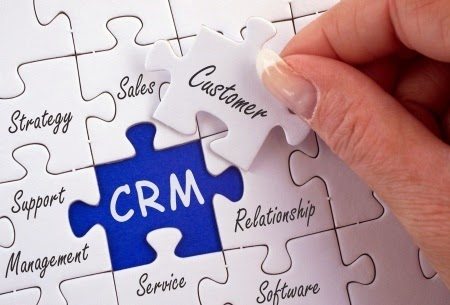
Six Tips to Select the Right CRM System
by Chris Fritsch, Client Success Consultant
 Research estimates that up to 70% of CRM systems fail to meet expectations – and a failed CRM implementation can be extremely costly, not just in terms of the financial expense, but also because of the costs in lost time – and credibility. Even more impactful: you don’t often get a second chance at CRM success. This means that it’s critical to select the right CRM system.
Research estimates that up to 70% of CRM systems fail to meet expectations – and a failed CRM implementation can be extremely costly, not just in terms of the financial expense, but also because of the costs in lost time – and credibility. Even more impactful: you don’t often get a second chance at CRM success. This means that it’s critical to select the right CRM system.
The good news is, CRM success is possible. If you simply follow a few critical steps before and during the CRM selection process,

Contact Management 101: Understanding the Payoff
by Chris Fritsch, Client Success Consultant

The reasons why attorneys manage their contacts in different ways isn’t important, but the challenge this presents for law firms is. A centralized collection of clean, correct and complete contacts is critical to effective marketing and business
development. Additionally, having contact and relationship information outside the firm’s central systems and security may present additional problems. As a result, many firms may find it important to get attorneys to develop consistent practices for centralized contact management.
So, what is the best way for firms to control the contact conundrum?

Data Quality Do’s and Don’ts – Part 6: The CRM Adoption Wreck
CRM adoption has the greatest potential for a wreck. Having worked with almost a hundred firms to help them achieve and enhance CRM success over the last eight years, the biggest challenge we always seem to run into is CRM adoption. Firms consistently tell us that their CRM system is literally a ‘wreck’ due, in large part, to poor participation.
 These firms frequently say that in the beginning of the CRM deployment, everything seemed to be running fine. They purchased the right system and implemented it without a hitch. The system was firing on all cylinders,
These firms frequently say that in the beginning of the CRM deployment, everything seemed to be running fine. They purchased the right system and implemented it without a hitch. The system was firing on all cylinders,
Pipeline to Success
What gets measured gets done, and this can certainly be said about “non-billable” activities in law firms. For anyone familiar with attorneys, this is not surprising. Busy lawyers are tasked with competing demands for their very valuable – and very limited – time. And for lawyers, time is money – literally. So when there is client work to be done, anything that takes away from billing often ends up being put off until they have time – which sometimes means indefinitely.
But as competition for work has increased recently, law firms are finally being forced to focus on the one non-billable activity that makes all the other billable activities possible: business development.

Pipeline to Success – Part 7: The People
Are your people onboard with business development pipeline success? To ensure a successful outcome. the business development pipeline technology must first be supported at the highest leadership levels in the law firm. Next, there must be knowledgeable, well-trained people dedicated to inputting the data. Information has to be entered correctly, consistently and completely because bad data will undermine attorney trust. Additionally, resources have to be dedicated to ongoing data quality to ensure the data remains current over time, since up to 30% of a firm’s contact data can become outdated each year. Finally, there has to be a focus on system adoption.

Pipeline to Success – Part 6: The Problem
Over the years, we have all heard way too many stories of CRM systems failing to meet expectations. What we don’t typically hear is that the reason why these systems didn’t meet expectations was often that the expectations were unrealistic. Indeed, people have been complaining about CRM systems for as long as…well, as long as there have been CRM systems (and these complaints are not limited to law firms.) Managing expectations is a key part of your CRM strategy.
CRM Strategy: Set Realistic Expectations
 The main problem with CRM technology is that it’s just technology.
The main problem with CRM technology is that it’s just technology.

Pipeline to Success – Part 5: The Products
Recently, some CRM product developers have begun building pipeline tools to meet the changing needs of law firms. A few years ago, Microsoft began offering a version of its Dynamics CRM through industry vertical resellers who configured the software specifically for law firms. This product, CRM4Legal, has since been acquired by Aderant. Two other companies have also released new offerings built on the Dynamics platform: Business Development Premier from Thomson Reuters and ProfessionalCRM from Consulting4CRM.
Leveraging Contacts and Relationships for New Opportunities
More recently, LexisNexis InterAction, the industry leading CRM for large law firms,

Pipeline to Success – Part 4: The Past
When some larger firms with sophisticated marketing departments began to realize the limitations of spreadsheets years ago, they started looking for alternatives. But because the profession had not been focused on sophisticated business development tracking or technology in the past, there were not many choices of pipeline software available that could meet the specific needs of law firms.
 So as an interim solution, some firms started testing CRM technology and software such as Salesforce to help overcome the limitations of spreadsheets. While these CRM systems included advanced pipeline functionality, unfortunately they didn’t make sense for a firm wide deployment.
So as an interim solution, some firms started testing CRM technology and software such as Salesforce to help overcome the limitations of spreadsheets. While these CRM systems included advanced pipeline functionality, unfortunately they didn’t make sense for a firm wide deployment.

Pipeline to Success – Part 3: The Pipeline
 This is where real pipeline software can help to take a law firm’s business development to the next level. A true business development pipeline allows opportunities to be entered and linked to related people and companies. Pipelines also allow for entry of additional information such as activities related to an opportunity, which can then be assigned to the individuals who need to complete them. Once all the data is entered, a pipeline can also provide a perpetual history of the activities that took place during the business development cycle and reminders for activities to keep advancing the opportunities forward.
This is where real pipeline software can help to take a law firm’s business development to the next level. A true business development pipeline allows opportunities to be entered and linked to related people and companies. Pipelines also allow for entry of additional information such as activities related to an opportunity, which can then be assigned to the individuals who need to complete them. Once all the data is entered, a pipeline can also provide a perpetual history of the activities that took place during the business development cycle and reminders for activities to keep advancing the opportunities forward.

Pipeline to Success – Part 2: The Spreadsheet vs The Pipeline
 At its most basic, a pipeline is simply a way to track and report on business development efforts. Initially, when law firms began tracking business development opportunities, the original tool of choice was Excel. Even at some of the largest firms, lawyers often tended to gravitate to spreadsheets to track just about everything. There are several reasons: they are easy to use, they’re on the desktop, they allow you to enter almost unlimited information, and they can even be used to print detailed lists and colorful charts and graphs. As a result, for many firms, Excel was a good place to start building a basic business development pipeline.
At its most basic, a pipeline is simply a way to track and report on business development efforts. Initially, when law firms began tracking business development opportunities, the original tool of choice was Excel. Even at some of the largest firms, lawyers often tended to gravitate to spreadsheets to track just about everything. There are several reasons: they are easy to use, they’re on the desktop, they allow you to enter almost unlimited information, and they can even be used to print detailed lists and colorful charts and graphs. As a result, for many firms, Excel was a good place to start building a basic business development pipeline.

Pipeline to Success – Part 1: Law Firms Finally Embracing CRM for Business Development Tracking
What gets measured gets done. This can certainly be said about “non-billable” activities in law firms. For anyone familiar with attorneys, this is not surprising. Busy lawyers are tasked with competing demands for their very valuable – and very limited – time. And for lawyers, time is money – literally. So when there is client work to be done, anything that takes away from billing often ends up being put off until they have time – which sometimes means indefinitely.
Business Development Pipeline Saves Time
But as competition for work has increased recently,
Categorizing CRM Contacts – Let Me Count the Ways
Categories are frequently used to break your CRM database into more manageable groups or classifications or to target or segment your contacts. There are many reasons – and variety of ways – to categorize your CRM contacts:
They Love Me
One of the most frequently used categories is ‘clients’. These are often ripe targets for cross selling and other business development efforts. The idea is that, since they already are writing you checks, presumably they like you – and might want to do even more work with you. They are also the ones you want to make sure you keep in contact with and communicate with regularly.

Communication for CRM Success Part 2: Why Should Attorneys Care about CRM?
Human nature dictates that we all tend to do things that are in our best interest. This is especially true in the context of technology adoption in a law firm. For attorneys, time is money, literally, so they are not going to waste any of their precious and limited time doing things that they don’t consider important. This means that to drive CRM adoption in the law firm, first you have to make them care.
CRM With a Purpose
Why should lawyers care about CRM adoption? Well, first it’s important to communicate why the firm cares.

The Business Development Trickle Effect
Drip… drip… drip… That little drop of water trickling down the sink drain often seems pretty insignificant. But over time, those small drips add up. In fact, one drip per second is actually 86,400 drips in a day. In a year, a few little drips here and there can add up to between 500 and 2,000 gallons of wasted water. Now that seems a little more significant – especially if you’re the one paying the water bill.
Little Efforts Can Produce Big Results
It’s the same with business development. Little things can mean a lot. You don’t have to try to do lots of big things.

Outsourcing Options and Opportunities – Part 3: Law Firms in the Outsourcing Business?
Outsourcing is defined as the contracting out of an internal business process to a third party organization and, as such, it has been a common and accepted business practice for a very long time.
By that definition, could it also be suggested that law firms themselves are in the outsourcing business? If you think about it, many companies have plenty of in-house attorneys and/or legal departments that can adequately serve most of their corporate legal needs. But in many cases, it makes more sense for them to hire outside firms or attorneys because they have deep knowledge or specialized experience in niche areas or because they can do some types of work more efficiently.




